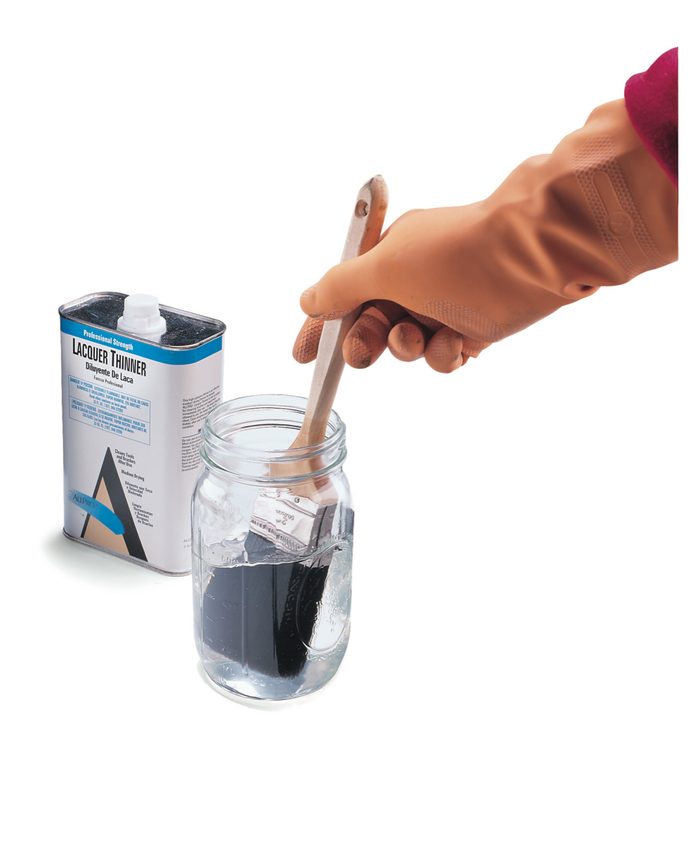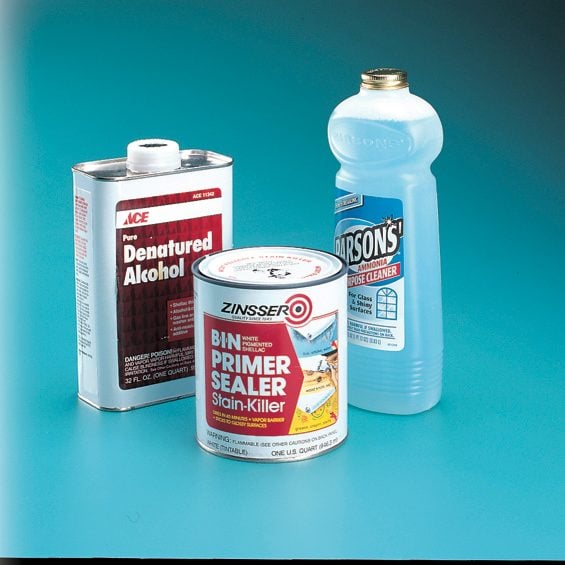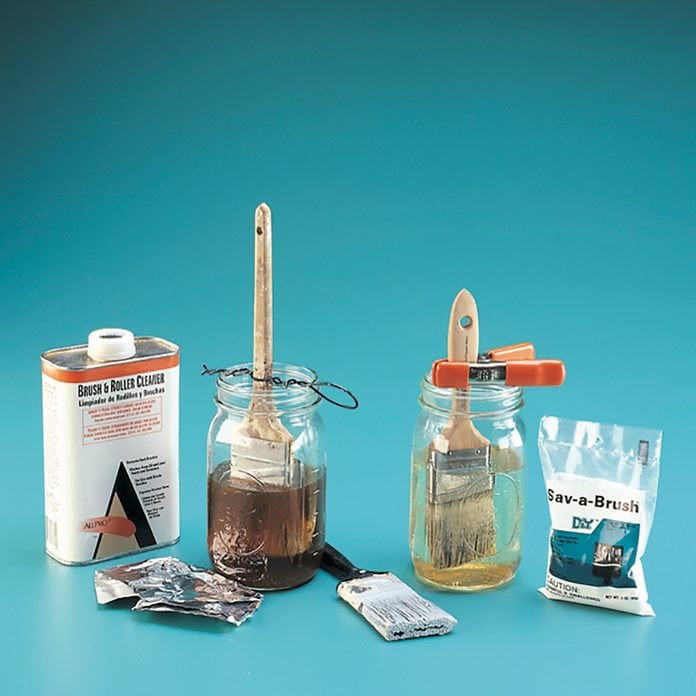What Solvent Is Used To Clean Paint Brushes
How to Clean Paint Brushes
Cleaning tips for pigment brushes, whether you're using latex-, oil- or shellac-based paint.
![]() Time
Time
A few hours
![]() Complexity
Complexity
Beginner
![]() Cost
Cost
$20-50
Introduction
Good pigment brushes are worth the money, whether yous're painting with latex, oil or shellac. Here's how the pros clean up their expensive pigment brushes. Plus, nosotros included some tips at the finish for reviving your petrified paint brushes.
Tools Required
Materials Required
- Denatured alcohol
- Household ammonia
- Lacquer thinner
- Newspaper
- Pigment thinner
A Good Paint Job Starts With a Adept Brush
1 expensive pigment brush is fashion better than a scattering of cheap brushes. Get a practiced nylon or polyester brush for painting with latex and a practiced natural (animal pilus) bristle brush for oil paints. Don't use a natural-bristle brush for water-based paints like latex. The natural fibers will peachy, lose their shape and eventually lose their strength, too. If you lot tin't get the buying information you need from a home center or hardware store, go to a retail paint shop for assistance.
Project step-by-step (14)
Step 1
Cleaning H2o-based Finishes & Latex Paint From Brushes
Scrape Off Excess Pigment
- Use the rim of a tin so work some of the pigment onto newspaper before cleaning in soapy water.

Step 2
Wash the Castor In a Pail of Soapy Water
- Work the pigment free of the bristles with your easily and a brush comb.

Step 3
Spin the Brush In a Pail
- Remove any remaining paint and h2o.
Spin flammable solvents but in well-ventilated areas away from furnaces, pilot lights and electrical devices of all kinds. Outdoors is all-time.

Pace 4
Rinse the Bristles In a Pail of Clean Water
- Work the bristles with your hand. Later a few minutes, spin the brush once more and and then rinse information technology in another pail of clean water.

Footstep v
Wrap the Brush With Heavy Paper
- Pre-fold the paper as shown, then wrap it around the brush and necktie it loosely with string.
- Pro Tip: This stride is critical to retain the shape of the castor

Pace 6
Cleaning Oil-based Varnishes & Paint From Brushes
When learning how to make clean oil paint brushes e'er work in a well-ventilated area when cleaning brushes in solvents such as paint thinner, lacquer thinner, alcohol and ammonia. In fact, it'southward best to piece of work exterior. Don't ever clean solvent-laden brushes effectually water heaters, stoves or whatsoever device with an open flame or potential electrical spark. Keep the solvents in proper, well-marked containers out of reach of children and pets.
Pace 7
Rinse the Brush Thoroughly in Paint Thinner
- Work the beard with your hands
- Pro Tip: Vesture chemical-resistant gloves, which are available at your hardware store or home centre.
- If necessary, utilise a brush comb to get rid of pigment clinging to the castor.
- Note: This is less of a trouble with oil paint than with latex.

Step eight
Spin the Brush for x Seconds
- Use a brush-and-roller spinner after nearly all the paint solids are out of the castor.
Footstep ix
Dip Brush Into Clean Pigment Thinner
- Piece of work whatsoever remaining paint out of the beard.
- Pro Tip: Agitate the beard for at to the lowest degree two minutes.
Footstep ten
Spin Brush a Second Time
- Apply a castor-and-roller spinner
Step eleven
Dip in Lacquer Thinner
- Agitate the brush for nearly a infinitesimal to remove any remaining pigment residue;
- Shake the brush onto newspaper to remove the lacquer thinner and residue.
Lacquer thinner is extremely combustible—exist sure to exercise this outside.

Stride 12
Clean the Brush in a Bucket of Soapy H2o
- Use laundry or dish soap. Work the bristles for only one minute.
- Note: Purists may not want to do this, especially with natural-bristle brushes, but a quick cleaning with water won't damage the bristles.
- Spin the castor free of water so shape the castor every bit shown above.
Pro Tip: Don't dump the paint thinner when you're finished. Let the paint solids settle to the bottom of the jar, then pour off the rest into a clean container. Let the solids dry out outdoors and then dump them in the trash for landfill or chancy waste product. Phone call your local trash service for proper disposal.
Step 13
Cleaning Shellac-based Paint From Brushes
Cleaning clear shellac varnish or pigmented shellac paints requires a different solvent than does latex and oil. You lot must employ denatured alcohol or an ammonia household cleaner.
When using an ammonia solution:
- Mix it with warm water at twice the strength recommended for cleaning floors;
- Rinse the castor in lukewarm h2o, and spin and wrap information technology (as shown above);
- When using denatured alcohol, follow the aforementioned steps as for the oil-based paint cleanup, but use booze instead.

Step 14
Reviving Petrified Brushes
If you lot find your paint brushes have petrified since the last time you used them, don't throw them away. You tin purchase either of the brush cleaners shown below to dissolve the crusty difficult paint. Nevertheless, choose carefully.
- The solvent-based cleaner is smashing for any brush (natural or synthetic);
- The water-based cleaner on the correct is only good for synthetic brushes.
Both solvents will remove hardened latex and oil-based paint. The brushes must soak overnight (cover the container on the left with foil in a well-ventilated area). If the paint isn't softened subsequently 24 hours, allow the brushes soak some other solar day. You must suspend the brushes equally shown or the bristles permanently curve as they soften and settle into the lesser of the jar.
Once the bristles are supple, remove the brush and rummage away any solids.
- If you're using the solvent-based cleaner, soak the brush again for an hour in a clean solution to remove any more solids, then follow the procedure for cleaning oil-based pigment from brushes.
- If using the water-based cleaner, wash the brush in soapy h2o and follow the directions for cleaning latex pigment from a brush.

Source: https://www.familyhandyman.com/project/how-to-clean-paint-brushes/
Posted by: dawdide1988.blogspot.com


0 Response to "What Solvent Is Used To Clean Paint Brushes"
Post a Comment